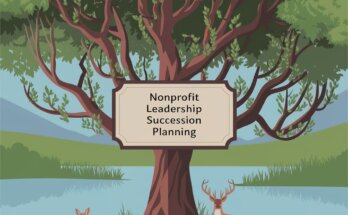Leading a nonprofit with a growth mindset is not just about having a positive attitude; it’s about fostering an environment where everyone feels empowered to learn, adapt, and thrive.
Nonprofit leaders often face unique challenges, from limited resources to high expectations. However, by embracing a growth mindset, you can inspire your team, engage your community, and ultimately drive your mission forward.
In this blog post, we’ll explore practical strategies for cultivating a growth mindset in your nonprofit organization. Along the way, we’ll share relatable stories and real-world examples to illustrate how these concepts can be applied effectively.
Understanding the Growth Mindset
Before diving into strategies, let’s clarify what a growth mindset is. Coined by psychologist Carol Dweck, a growth mindset refers to the belief that abilities and intelligence can be developed through hard work, dedication, and feedback.
In contrast, a fixed mindset assumes that talent is static and unchangeable.
Nonprofit leaders who adopt a growth mindset focus on improvement, resilience, and the potential for transformation.
Why a Growth Mindset Matters in Nonprofits
In the nonprofit world, challenges are a part of the landscape. A growth mindset enables leaders to view setbacks as opportunities for learning and improvement rather than as failures.
This perspective not only motivates staff but also fosters a culture of innovation. By leading with a growth mindset, you can create an environment where everyone feels encouraged to share ideas, take risks, and collaborate.
Strategy 1: Encourage Continuous Learning
One of the hallmarks of a growth mindset is a commitment to continuous learning. As a nonprofit leader, you should prioritize ongoing education for yourself and your team.
This might include attending workshops, webinars, or conferences relevant to your mission and operations.
Example: Consider a nonprofit focused on environmental conservation. The leadership team might attend annual conferences on sustainable practices, bringing back new ideas to implement in their programs.
Additionally, they could offer regular training sessions for staff on emerging trends in environmental science, equipping them with the knowledge needed to adapt their strategies.
Strategy 2: Foster Open Communication
Open communication is crucial for nurturing a growth mindset within your organization.
Encourage team members to voice their thoughts, ideas, and concerns without fear of criticism. Create regular check-in meetings where everyone can share their progress, challenges, and insights.
Example: A nonprofit supporting mental health might implement weekly team meetings where staff can discuss their current projects. These meetings would provide a platform for team members to seek advice, share successes, and brainstorm solutions to obstacles they encounter. By fostering an atmosphere of trust, leaders can empower employees to take ownership of their work.
Strategy 3: Embrace Failure as a Learning Opportunity
In a growth-minded nonprofit, failure is not the end of the road; it’s a stepping stone toward success. Encourage your team to view mistakes as valuable learning experiences. This shift in perspective can lead to innovative solutions and improvements.
Let’s take a moment to consider a small nonprofit dedicated to promoting literacy among children. After launching a new reading program, they noticed low attendance in the first few weeks. Instead of giving up, the team gathered to analyze the situation. They realized that their marketing efforts had missed the mark; parents were unaware of the program’s benefits.
Instead of labeling this as a failure, the leadership team convened a brainstorming session, encouraging everyone to contribute ideas for reaching out to the community.
As a result, they developed a new outreach strategy that involved partnering with local schools and libraries.
Attendance skyrocketed in the following months, and the program received positive feedback from families.
This experience not only improved the program but also strengthened the team’s commitment to collaboration and creativity.
Strategy 4: Set Achievable Goals
Setting clear, achievable goals helps create a sense of purpose and direction within your organization. When team members see progress toward their objectives, it reinforces their belief in their abilities.
Example: A nonprofit focused on animal rescue might set quarterly goals for the number of animals rescued, adopted, or rehabilitated. By breaking down the larger mission into smaller, manageable goals, the team can celebrate their successes along the way. This practice fosters motivation and encourages individuals to strive for continuous improvement.
Strategy 5: Provide Constructive Feedback
Feedback is essential for growth. As a leader, it’s your responsibility to offer constructive feedback that focuses on improvement rather than criticism. When providing feedback, emphasize specific behaviors and outcomes rather than personal attributes.
Example: If a team member struggles with grant writing, instead of saying, “You’re not a good writer,” you might say, “I noticed some sections of the grant application could benefit from more detailed explanations. Let’s work together to enhance those areas.” This approach not only helps the individual grow, but also demonstrates your commitment to their development.
Strategy 6: Celebrate Efforts and Achievements
Recognizing and celebrating both small and large achievements can boost morale and reinforce a growth mindset within your team. Acknowledging hard work and dedication fosters an environment where individuals feel valued and motivated.
Example: Host monthly recognition events to celebrate staff and volunteer contributions. These can be as simple as shout-outs during team meetings or more formal gatherings with awards. Recognizing efforts not only boosts morale but also encourages everyone to strive for their best.
Strategy 7: Encourage Collaboration and Teamwork
Collaboration is a powerful driver of innovation. Encourage team members to work together on projects, share insights, and leverage each other’s strengths. This teamwork can lead to new ideas and solutions that a single individual might not have conceived.
Example: A nonprofit focused on health education could form cross-departmental teams to tackle specific projects, such as community health fairs. By bringing together individuals with different expertise, the organization can develop comprehensive programs that address various community needs.
Strategy 8: Lead by Example
As a leader, your actions set the tone for the organization. If you model a growth mindset through your behaviors and attitudes, your team will likely follow suit. Demonstrate your commitment to learning, seek feedback, and openly share your own challenges and growth experiences.
Example: Share your own professional development journey with your team. Whether you’re taking courses, reading relevant books, or attending conferences, let your team see your dedication to growth. This transparency fosters a culture of openness and encourages others to pursue their own development.
Strategy 9: Adapt to Change
In the nonprofit sector, change is inevitable. A growth mindset equips leaders and teams to adapt to new circumstances, whether that’s shifting community needs, funding challenges, or changes in technology.
Example: A nonprofit focused on job training might find that the local job market shifts dramatically due to economic changes. Instead of clinging to outdated programs, the leadership team can pivot, researching new industries and developing training programs that align with emerging job opportunities. By embracing change, the organization remains relevant and effective in fulfilling its mission.
Strategy 10: Measure Impact and Adjust Strategies
Lastly, measuring your organization’s impact is crucial for fostering a growth mindset. Use data to evaluate your programs, assess your effectiveness, and identify areas for improvement.
Example: A nonprofit working on homelessness could track key metrics, such as the number of individuals housed, job placements, or community engagement. By analyzing this data, the organization can adjust its strategies to better serve its clients and enhance its programs.
Conclusion
Leading a nonprofit with a growth mindset is a transformative journey.
As you embark on this journey, remember that every step counts. By cultivating a growth mindset within your nonprofit, you not only empower your team but also amplify your impact in the community.
If you’re looking for more expert tips and resources to help your nonprofit succeed, subscribe to the Nonprofit Navigators Newsletter today! You’ll gain access to valuable insights, strategies, and the latest trends to help your organization thrive.
Additionally, don’t forget to download our free resource: Top 10 Donor Stewardship Strategies for Nonprofits + Free Donor Engagement Checklist. This guide will provide you with actionable tips to enhance your donor relationships and ensure long-term support for your mission.
Embrace the power of a growth mindset today and watch your nonprofit soar to new heights!




